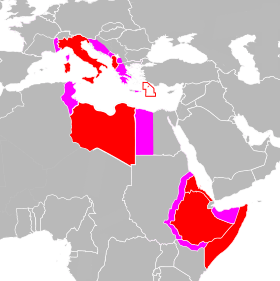Italian Spahis
Italian Spahis were light cavalry colonial troops of the Kingdom of Italy, raised in Italian Libya between 1912 and 1942.[1]
Characteristics
The Italian colonial administration of Libya raised squadrons of locally recruited Spahi cavalry after the conquest of Libya from the Ottoman empire.
These differed from their French namesakes in that their prime role was that of mounted police, tasked with patrolling rural and desert areas. The name is the French form of the Ottoman word sipahi, a word originally derived from Middle Persian term Spah meaning "army", or "horsemen".
Although they had Italian officers these spahis were more loosely organised than the regular Libyan cavalry regiments (Savari). They usually wore a picturesque dress modelled on that of the desert tribesmen from whom they were recruited.
History
The Italian Spahis formed part of the Regio Corpo Truppe Coloniali of Libya (Royal Corps of Libyan Colonial Troops), which included desert and camel troops, infantry battalions, artillery and cavalry. The Truppe Coloniali saw extensive service during the Italian conquest of Tripolitania and mainly contributed to the full control of Cyrenaica & Fezzan, which was not completed until 1932. Subsequently, they patrolled the border areas of Italian Libya.
In 1936 Spahis and other Libyan units took part in the Italian invasion of Ethiopia and received a "Gold Medal of Honor" for their distinguished performance in battle [2]
The Spahis of Amedeo Guillet
The Italian officer Amedeo Guillet commanded a "gruppo" of spahi irregular cavalry in Libya during 1934. The following year he and his Libyan spahis took part in the Invasion of Ethiopia.
World War II
On the eve of Italy's entry into World War II the Royal Corps of Libyan Colonial Troops comprised approximately 28,000 locally recruited personnel, including nearly one thousand Spahis.
The Libyan colonial infantry and artillery suffered heavy losses during the Battle of the Marmarica (December 1940) and were formally disbanded in January 1943 following the Italian withdrawal into Tunisia. The role of the Libyan Spahis and other mounted troops was limited mainly to patrol and scouting work by the demands of modern mechanized warfare. Spahi detachments were in control of Ghat and Ghadames until the first weeks of 1943.
Notes
Bibliography
- Antonicelli, Franco. Trent'anni di storia italiana 1915–1945. Mondadori. Torino, 1961.
- Crociani, Pietro. Le Uniformi Coloniali Libiche 1912–1942 La Roccia editore. Roma, 1980

